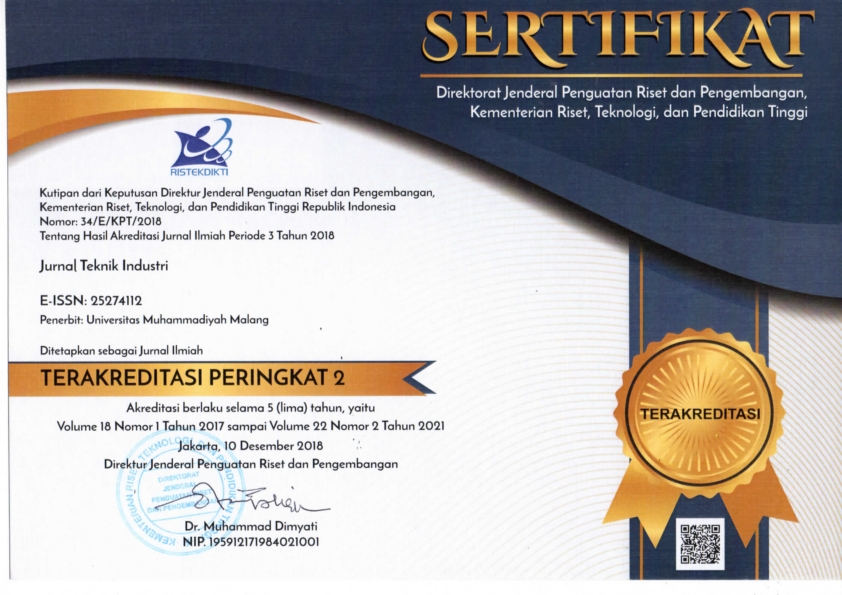Analisis Kinerja Lingkungan Dan Produktivitas Dengan Menggunakan Konsep Green And Lean Productivity
DOI:
https://doi.org/10.22219/JTIUMM.Vol17.No1.31-41Keywords:
Green Productivity, Liquid Waste, Story Aeration Technology, EPI, Productivity, PDAMAbstract
Regional Water Company (PDAM) Lamongan is a local company with main activity is to serve and provide clean water to communities through a system of pipes. Constraint occurs is in the process of drinking water treatment and wastewater sludge yield potential as a source of environmental pollution. Another problem is still limited because of PDAM services in 2013 is only capable of serving 4.7% of the total number of households (BPS population census of 2010). Taps need to increase the amount of water production in order to serve the wider community Lamongan. The concept of green productivity (GP) can be used in the search for solutions to increase productivity and protect the environment. The study begins by identifying the root cause of a lot of liquid waste and a low amount of water production, setting objectives and targets, choosing the resources and information available to arrange alternative green productivity. There are two alternatives, the selected alternative in this study are alternative 2 merge maximizing the raw water intake (pipe repair, purchase and installation of the intake screen 2 pump intake of government), Repair IPA II, and the use of wastewater that is the use of waste as material raw returned by first applying multilevel aeration technology to reduce levels of COD and BOD5 in wastewater. The productivity of the company in the first year after implementation of the selected alternative to 123%, an increase of 14% compared to the year 2013 and the total value of the EPI index to 18.35 or increased 42.65, which means it meets effluent standards wastewater East Java Governor Regulation No. 72 of 2013. In addition the production of water PDAM also increased 69.8% over the previous year.Downloads
References
A. P. Organization, Green Productivity Training Manual: Tokyo:APO 2001.
M. Rüßmann, M. Lorenz, P. Gerbert, M. Waldner, J. Justus, P. Engel, et al., "Industry 4.0: The future of productivity and growth in manufacturing industries," Boston Consulting Group, vol. 9, 2015.
N. Semenova and L. G. Hassel, "On the validity of environmental performance metrics," Journal of Business Ethics, vol. 132, pp. 249-258, 2015.
M. Puig, C. Wooldridge, and R. M. Darbra, "Identification and selection of environmental performance indicators for sustainable port development," Marine pollution bulletin, vol. 81, pp. 124-130, 2014.
S. Bracco, F. Delfino, F. Pampararo, M. Robba, and M. Rossi, "A mathematical model for the optimal operation of the University of Genoa Smart Polygeneration Microgrid: Evaluation of technical, economic and environmental performance indicators," Energy, vol. 64, pp. 912-922, 2014.
J. Hřebíček, J. Soukopová, M. Štencl, and O. Trenz, "Corporate key performance indicators for environmental management and reporting," Acta Universitatis Agriculturae et Silviculturae Mendelianae Brunensis, vol. 59, pp. 99-108, 2014.
D. N. Tran and L. A. Bero, "Barriers and facilitators to the quality use of essential medicines for maternal health in low–resource countries: An Ishikawa framework," Journal of global health, vol. 5, 2015.
A. Ismail, "Pengolahan Limbah Cair dari Industri Biskuit Dengan Proses Aerasi Bertingkat. Seminar Nasional Teknik Kimia Indonesia Yogyakarta," ISBN 979-97893-0-32003.
M. Tahir, U. B. Khalid, and M. Waseem, "’Evaluation of Variation in Benefit Cost Ratio (bcr) and Yield of Mungbean (Vigna Radiata L.) due to Influence of Different Sources and Levels of Phosphorus," Custose agronegocio on line, vol. 11, pp. 23-34, 2015.
A. Shaw, G. Wint, G. Cecchi, S. Torr, R. Mattioli, and T. Robinson, "Mapping the benefit-cost ratios of interventions against bovine trypanosomosis in Eastern Africa," Preventive veterinary medicine, vol. 122, pp. 406-416, 2015.











